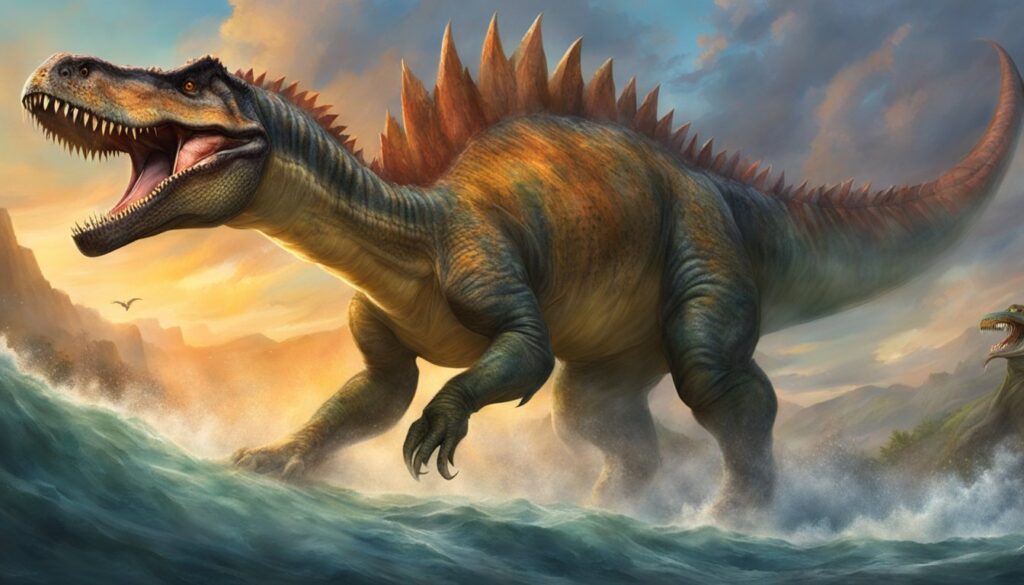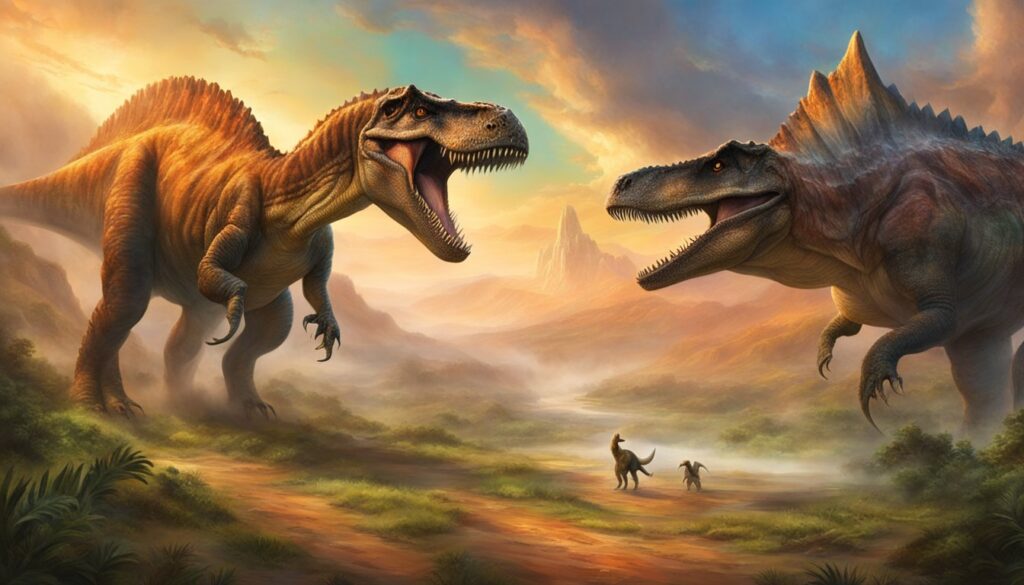Dinosaurs have always been a fascinating topic of discussion, and the debate about which dinosaur would win in a fight has been a long-standing one. Among the most popular contenders are the Spinosaurus and the T-Rex. Both of these prehistoric beasts were apex predators of their respective times, but who would emerge victorious in a head-to-head battle?

The Spinosaurus, also known as the “spiny lizard,” was a massive dinosaur that lived during the Cretaceous period. With its long, narrow snout and sail-like structure on its back, the Spinosaurus was a formidable predator. On the other hand, the T-Rex, also known as the “tyrant lizard king,” lived during the late Cretaceous period and was one of the largest land predators to ever exist. With its powerful jaws and massive size, the T-Rex was a force to be reckoned with.
In this article, we will take a closer look at the Spinosaurus and the T-Rex and compare their physical attributes, hunting strategies, and other factors to determine who would come out on top in a fight. Without further ado, let’s dive into the comparative analysis of these two prehistoric giants.
Key Takeaways
- The Spinosaurus and the T-Rex are two of the most popular contenders in the debate about which dinosaur would win in a fight.
- The Spinosaurus was a massive dinosaur with a long, narrow snout and a sail-like structure on its back, while the T-Rex was one of the largest land predators to ever exist.
- In the following sections, we will compare the physical attributes, hunting strategies, and other factors of these two dinosaurs to determine who would emerge victorious in a head-to-head battle.
Spinosaurus Overview

Physical Characteristics
Spinosaurus is a genus of theropod dinosaur that lived during the Late Cretaceous period, approximately 112 to 97 million years ago. It was a large and powerful predator, with a distinctive sail on its back that was formed by elongated spines on its vertebrae. Spinosaurus was one of the largest carnivorous dinosaurs, with estimates of its length ranging from 12 to 18 meters and its weight from 7 to 20 tons.
The skull of Spinosaurus was long and narrow, with conical teeth that were ideal for catching fish. Its arms were relatively short, but its claws were large and powerful. The legs of Spinosaurus were long and strong, allowing it to move quickly on land and in water.
Habitat and Behavior
Spinosaurus lived in what is now North Africa, in a region that was dominated by rivers and swamps. It was adapted to a semiaquatic lifestyle, and its elongated snout and conical teeth suggest that it primarily fed on fish. Spinosaurus was also capable of hunting on land, and it may have preyed on other dinosaurs and large animals.
Spinosaurus was a solitary predator, and it likely spent much of its time hunting and patrolling its territory. It may have also engaged in intraspecific combat, using its powerful jaws and claws to defend its territory or compete for mates.
Paleontological Discoveries
The first Spinosaurus fossils were discovered in Egypt in the early 20th century, but many of these specimens were lost during World War II. In recent years, new Spinosaurus fossils have been discovered in Morocco, providing new insights into the anatomy and behavior of this enigmatic dinosaur.
Recent studies of Spinosaurus fossils have also suggested that it was capable of swimming, and may have spent much of its time in the water. This has challenged previous ideas about the behavior and ecology of Spinosaurus, and has led to new questions about how this dinosaur lived and hunted.
T-Rex Overview

Anatomical Features
Tyrannosaurus Rex, or T-Rex, is one of the most iconic dinosaurs known for its massive size and powerful jaws. It was a bipedal predator that stood up to 20 feet tall and weighed up to 9 tons. Its long, thick tail provided balance and stability while running and turning.
The T-Rex had a large, heavy skull with powerful jaws that could exert a force of over 12,000 pounds per square inch. Its teeth were serrated and up to 12 inches long, which were used to grip and tear apart its prey. Its vision was also keen, with eyes located at the front of its skull, giving it binocular vision and depth perception.
Predatory Skills
The T-Rex was an apex predator, meaning it was at the top of the food chain. Its size and strength allowed it to take down large herbivores like Triceratops and Edmontosaurus. Its hunting technique was to ambush its prey, using its powerful legs to quickly close in and deliver a fatal bite.
The T-Rex was also known for scavenging, meaning it would feed on the carcasses of dead animals. Its strong sense of smell allowed it to locate these food sources from miles away.
Fossil Record Analysis
The T-Rex lived during the Late Cretaceous period, approximately 68 to 66 million years ago. Its fossils have been found in North America, with the most famous specimen being “Sue” found in South Dakota in 1990.
Scientists have analyzed the T-Rex’s bones and teeth to learn more about its behavior and physiology. They have discovered that the T-Rex grew rapidly during its teenage years, reaching full size by the age of 20. They have also found evidence of injuries and diseases, suggesting that the T-Rex was a tough and resilient predator.
The T-Rex was a formidable predator with impressive anatomical features and predatory skills. Its large size and powerful jaws made it a force to be reckoned with in the Late Cretaceous ecosystem.
Comparative Analysis

Size and Strength
Spinosaurus and T-Rex were two of the largest and strongest dinosaurs to ever roam the earth. Spinosaurus was the largest carnivorous dinosaur, measuring up to 59 feet long and weighing up to 23 tons. T-Rex, on the other hand, was slightly smaller, measuring up to 40 feet long and weighing up to 15 tons.
In terms of strength, both dinosaurs had powerful jaws and sharp teeth, but Spinosaurus had a longer and more slender snout, which may have allowed it to catch fish more easily. T-Rex, on the other hand, had a more robust skull and a more powerful bite force, which may have allowed it to crush bones and tear through flesh with greater ease.
Combat Strategies
Spinosaurus and T-Rex had different combat strategies. Spinosaurus was a semi-aquatic dinosaur, which means it was well adapted to hunting in water. It had long arms and claws, which may have allowed it to catch fish and other aquatic prey. T-Rex, on the other hand, was a land-based dinosaur and may have relied more on its powerful bite force and speed to catch prey.
Spinosaurus may have also used its sail to intimidate rivals or attract mates, while T-Rex may have used its size and strength to intimidate rivals and prey.
Environmental Adaptations
Spinosaurus and T-Rex had different environmental adaptations. Spinosaurus was adapted to living in wet, swampy environments, while T-Rex was adapted to living in drier, more open environments. Spinosaurus had webbed feet, which may have allowed it to swim more easily, while T-Rex had strong legs and powerful muscles, which may have allowed it to run faster and more efficiently.
Overall, both dinosaurs were well adapted to their respective environments and had unique strengths and weaknesses. It is difficult to determine which dinosaur would win in a hypothetical battle, as it would depend on a variety of factors such as location, size, and age.
Conclusion

In conclusion, both Spinosaurus and T-Rex were formidable predators in their respective time periods. While T-Rex was larger and had a stronger bite force, Spinosaurus had longer arms and a more powerful tail.
While it’s true that it’s challenging to definitively determine the outcome of a hypothetical battle between T-Rex and Spinosaurus, it’s worth noting that T-Rex possessed some advantages that might give it an edge in such a confrontation. T-Rex’s robust build, powerful bite force, and well-developed hind limbs likely provided it with superior strength and agility in close combat scenarios.
Additionally, T-Rex’s thick, sturdy skull and bone-crushing jaws were formidable weapons that could inflict devastating damage on its opponent. These factors suggest that in a direct confrontation, T-Rex might have had the upper hand, leveraging its sheer power and ferocity to overpower the Spinosaurus. However, without direct evidence, this remains speculative, and it’s essential to recognize the uncertainties surrounding such discussions.
The debate between Spinosaurus and T-Rex will continue to fascinate and intrigue paleontologists and dinosaur enthusiasts alike. The discovery of new fossils and advancements in technology may one day provide more conclusive evidence on which of these ancient predators truly reigned supreme.
